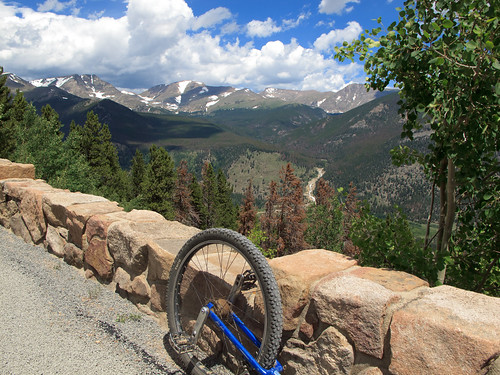Anyone who’s been on the forums for any length of time has enjoyed aspenmike’s photography, and wondered, “how could I possibly take pictures like that?” I recently discovered at least one key element: Ride up mountain passes in Colorado.
I was in Estes Park for a non-unicycling event, but being me, I brought a unicycle, and I had a day free to use it. My plan was to head towards Rocky Mountain National Park for a ride on the Old Fall River Road, a one-way dirt road up to the pass, and then to ride down the paved Trail Ridge Road (the highest continuous paved road in the U.S.) back to town.
I set out on my geared 29er, passing the Stanley Hotel (Stephen King’s inspiration for The Shining), where the climbing began in earnest. Unfortunately, as I entered the park I was informed that Old Fall River Road was closed due to damage from the harsh winter. Bummer deal; that meant I’d needlessly added about 4 miles onto my ride, and I had to ride pavement all the way up. Ah well, nothing to do but go for it.
Estes Park sits at about 7800 feet, which means that not long into the climb, I reached the highest elevation I’d ever ridden on one wheel (9000 feet, Mr. Toad’s in Tahoe). At first it wasn’t too bad; the climb on road is very gradual, and I was able to crank the high gear until the intersection with Highway 36 at approximately 9500 feet. At that point, though the road didn’t get any steeper, my oxygen supply didn’t allow for heroic effort, so I switched down to low gear. I had 150mm cranks on my 29er, which meant I was now moving quite slowly, but would not have any problems with leg power. (Lung power was another question).
After the turn, I had my second unfortunate discovery; I was riding on the same day road crews were putting down a new layer of chip seal, which is a major pain to ride on any kind of cycle. It was a weekday, so the traffic wasn’t too bad, but there would sometimes be lines of 8-10 cars and trucks kicking up dust and gravel.
Other than the road itself, the conditions were perfect; light wind, temps in the 70s, not too humid up on the mountain, and gorgeous views. I just kept cranking it up and stopping occasionally for photos and snacks.
After passing Rainbow Curve (~11,000 feet), I saw ahead what looked like a pass, and got energized to reach it. My third unfortunate discovery was that what had looked like the pass was only a hanging glacial valley, and the road continued to climb off into the distance after I crested the rise. Still, nothing to do but continue on, so I kept pushing.
At this point the altitude was becoming a serious problem. Even though I was riding very slowly and consciously monitoring my breathing, I was having trouble keeping forward momentum. My body was starting to shut down; I stopped a few times for water and food, but my stomach was clenched and didn’t want to consume anything new. My head was pounding and I began to question the wisdom of continuing on.
I passed signs warning people to be mindful of the alpine tundra; I was above the tree line, and now had to deal with a headwind as well as the altitude. I saw a couple of yellow-bellied marmots on the rocks. I was now stopping more often than I could reasonably justify for photographic reasons, and my physical condition was not improving as I went higher. After stopping at the Forest Canyon overlook (~11,700’) I cranked over one small rise hoping to see the pass, but again saw the road rising depressingly off into the distance. I also felt a few drops of rain from a cloud coming over the mountain. Out here unsupported, I decided it was unwise to push myself further, and turned around after reaching about 11,800’. I was perhaps 400’ of climbing and 2 miles short of the summit, but I’d have to leave it for another time.
On my first downhill stint back to Rainbow Curve I was still feeling the altitude, but after a rest I was able to get into the high gear groove and start making time. At one point I came upon a long line of cars moving very slowly, and passed at least 20 or 30 of them before coming to the pullout at Many Parks Curve, where one of the guys on the road crew (who caused the backup) asked to try my uni. He was able to ride it in low gear and made a passable attempt at high gear, not bad for someone who hadn’t done it before.
I cranked back into town just ahead of the rain, arriving just at Beer O’Clock.
I have to give mad props to aspenmike for doing this kind of ride all the time; it’s incredibly difficult to exert yourself at this kind of altitude, even for someone in great shape. The man’s a beast!
As for the pictures, it sure helps.

 I too am very jealous of Mikes riding abilities
I too am very jealous of Mikes riding abilities

